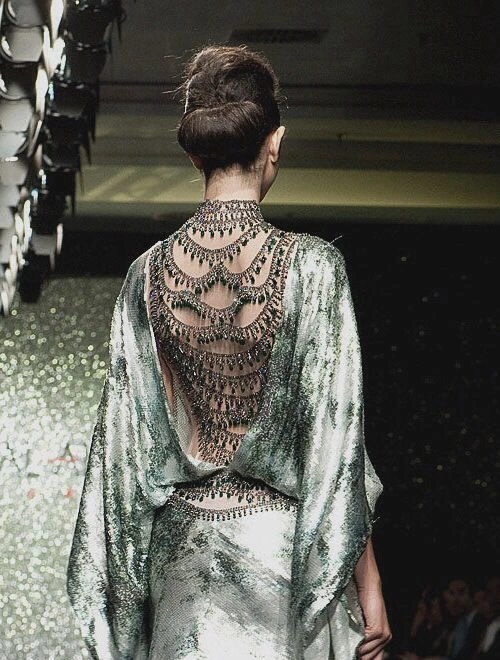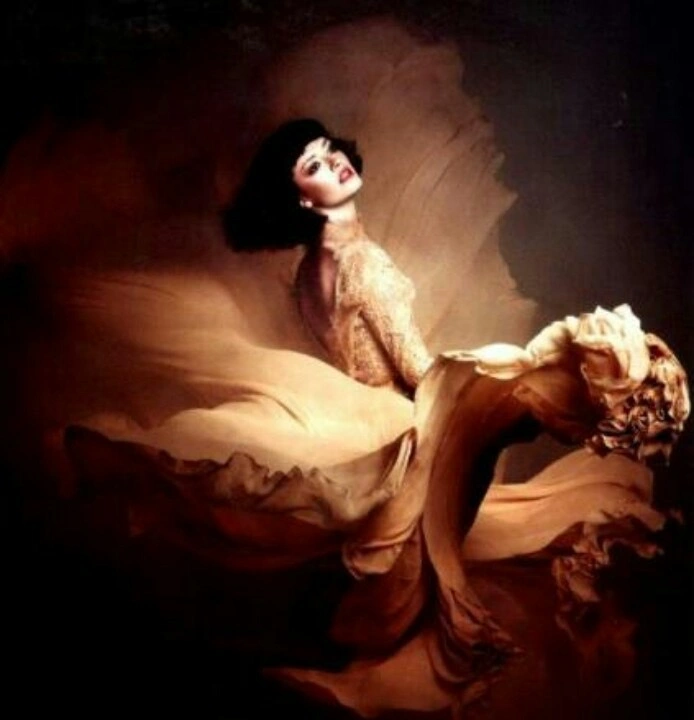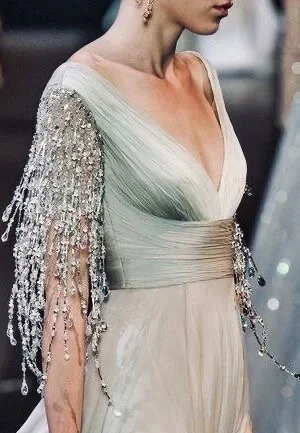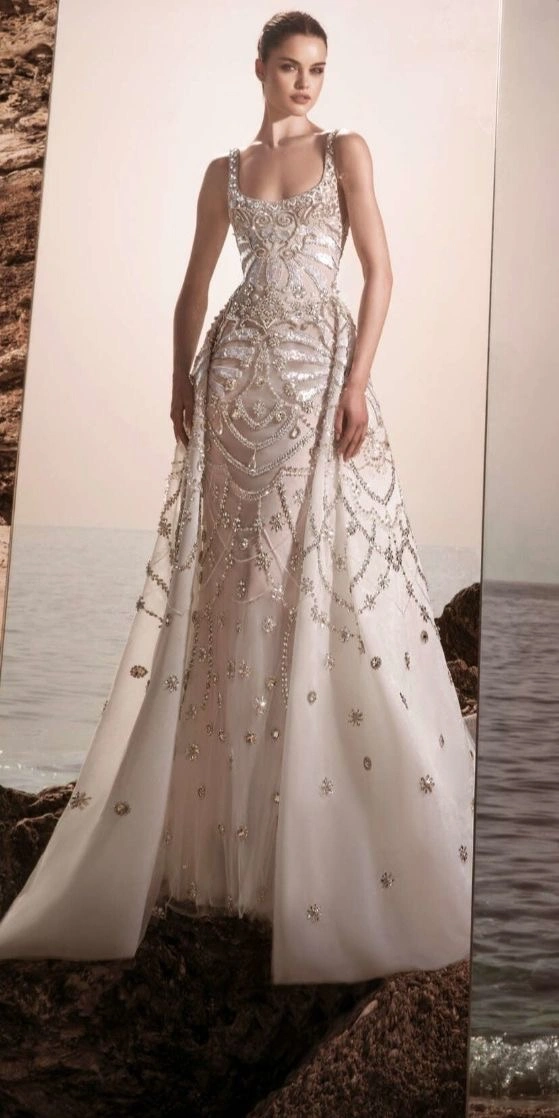Eveningwear & Couture
New Luxury Narratives Shaped by Middle Eastern Craft
By Raveena Parmar
In a world where fashion trends cycle faster than ever, couture remains one of the rare art forms that resists time. And nowhere is this resistance more poetic, and more powerful than in the Middle East. Here, eveningwear is more than glamour: It is memory, heritage and devotion stitched into silk. Today, a new generation of Middle Eastern designers is rewriting the meaning of modern luxury: one that balances structure and softness, opulence and restraint, heritage and innovation. Couture from the region is no longer content to be admired, but it demands to be felt.
Threads of Memory, Sculpted in Modernity
The soul of Middle Eastern couture lies in craftsmanship. Not as marketing rhetoric but as an inherited tradition. Generations of master artisans have perfected the sacred language of needle and thread, passing down hand-embroidery, beading, crystal placement, and metallic threadwork as forms of storytelling.
Lebanese couturier Elie Saab, the undisputed poet of eveningwear, once said, “Elegance is not about being noticed, it’s about being remembered.” His gowns, often drenched in constellations of Swarovski crystals and moonlit sequins, feel like preserved fragments of beauty. They whisper rather than shout.
This reverence for handwork echoes across ateliers from Beirut to Dubai, from Marrakech to Riyadh. Zuhair Murad turns embroideries into entire universes,star maps, baroque florals, and celestial motifs that seem destined for red carpet mythology. Georges Hobeika breathes softness into couture through feathers and silk petals that sway like poetry in motion. Rami Al Ali fuses Arab geometry with couture minimalism, proof that embellishment and purity can coexist.These designers are guardians of a legacy but they are also architects of a new future.
The Rise of Wearable Opulence
Once upon a time, couture was purely spectacle as it was beautiful but distant, untouchable beyond gala carpets and editorial fantasy. Today, Middle Eastern couture is evolving toward emotional wearability. Eveningwear now moves, adapts, and transforms to the rhythm of modern women.
Designers are responding to a new generation, to the one that wants clothes they can feel themselves in, not disappear beneath. The gowns are still breathtaking, but now they hold ease and softness. Structure is still celebrated, but it serves the body instead of restricting it. Shapes sculpt rather than suffocate; corsetry is lighter, and silhouettes embrace fluidity.


Even modesty, which is a key element in Middle Eastern fashion, has become a dimension of modern couture. Capes replace bare shoulders. Draping replaces deep cuts. Coverage becomes elegance rather than limitation. A new visual language is emerging: sensuality through silhouette, not exposure.
Craft Meets Innovation
The future of couture doesn’t abandon tradition; it transforms it. The growing demand for function in luxury has birthed modular eveningwear: gowns with detachable trains, adjustable sleeves, and removable crystal harnesses. Convertible couture allows a woman to wear a dramatic runway gown as both a red-carpet statement and a more intimate soirée look. It is an emotional and intelligent design.
In Dubai and Riyadh, experimental houses like Ashi Studio are redefining eveningwear through sculptural minimalism, using architectural structure and innovative materials to craft gowns that look like moving art. Meanwhile, designers from North Africa like Maison Sara Chraibi are infusing couture with symbolism, embedding Amazigh patterns, calligraphy, and spiritual geometry into contemporary shapes. Technology has also entered the atelier: laser-cut silks, 3D floral appliqué, and AI-assisted embroidery mapping are quietly shaping the future. Yet the heart of couture remains deeply human. Hours of labor. Devotion by hand. A relationship between maker and garment.
Red Carpet Power: The Middle Eastern Takeover
You can trace the power of Middle Eastern couture not only through ateliers but through pop culture itself. From Beyoncé’s golden tour gowns by Nicolas Jebran to Jennifer Lopez’s ethereal Zuhair Murad cape in Cannes, from Priyanka Chopra’s crystal-encrusted Elie Saab moment to Bella Hadid’s sculptural Ashi Studio gowns, the influence is global and undeniable. The Middle East isn’t just participating in the red carpet; it is defining its visual language. Celebrities now turn to these designers not just for spectacle but for storytelling. These gowns carry meaning, drama, and identity. They are wearable art and full of soul.
LUXURY WITH PURPOSE
Fashion Beyond Fantasy
A quiet revolution is also happening behind the seams. Many Middle Eastern designers are championing ethical luxury and artisan preservation. Instead of outsourcing production, they keep ateliers local, passing on artisanal skills to young generations. Couture becomes a way to preserve heritage rather than commercialize it.


Even sustainability, which was once seen as incompatible with couture, is now finding its way in. Rami Kadi experiments with recycled sequins along with other young Arab designers who are upcycling vintage fabrics from souks. Future couture is not only stunning but also conscious.
A New Luxury Narrative
The world once looked to Paris for couture, and today it looks East, too. Because in the Middle East, couture is not just a business,it is also a living legacy. Eveningwear is treated with emotion, and gowns are made to carry identity. Luxury is not excess, but it’s an expression.
The next chapter of couture belongs to designers who balance heritage and innovation, those who dare to imagine gowns that transcend time but move with the world. Designers who build cathedrals of embroidery and allow a woman to dance in them.
Middle Eastern couture is not just rising: It is redefining the global language of elegance, one handcrafted masterpiece at a time.
As someone who observes this industry not just with admiration but curiosity, I believe the true future of couture lies in honesty. Luxury today is not defined by price, but by purpose. What makes Middle Eastern couture stand out to me is not only its beauty, but its emotional depth, as it is one of the few fashion movements that still carries a soul. Yet I also think couture must continue evolving beyond fantasy. I want to see more designers embrace storytelling that resonates with real women, not just muses, but individuals with identities, cultures, and voices.
Perhaps this is why certain Middle Eastern designers connect so strongly with Gen Z. This generation is not easily impressed by extravagance alone because they look for authenticity, values, and emotional connection. Designers like Ashi Studio, Rami Kadi, and Maison Sara Chraibi understand this, and that’s the reason why they don’t design gowns; they build worlds. They speak about craftsmanship, cultural memory, sustainability, and emotion. They are present online and show their process. They don’t hide behind a fashion house façade but invite people behind the curtain. Gen Z connects with that transparency, since they don’t want perfection but purpose. And maybe that is the new luxury narrative: not couture that exists above the world, but couture that listens to it and evolves with it.
